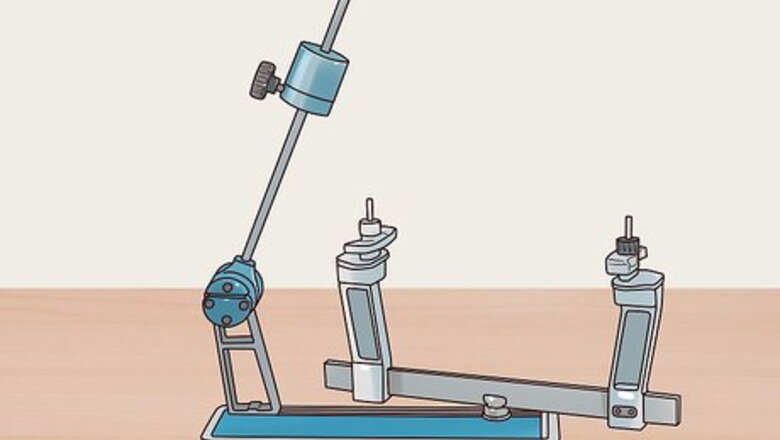
views
Preparing the Racquet
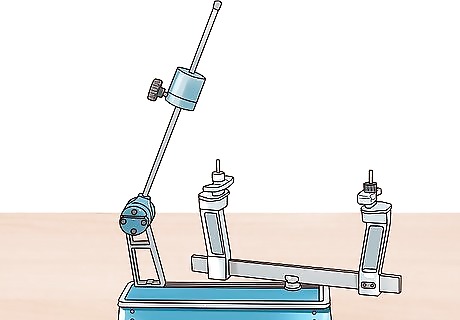
Find a suitable stringing machine. Many health clubs, sports stores, and gyms with tennis courts have string mounts they use to restring racquets at a cost, usually somewhere between $25-$50 a job. The machines themselves cost anywhere from $200 to several thousand dollars, depending on the quality. If you play tennis several times a week paying to have $6 worth of string put on your racquet can start to add up, and you'll be able to recoup the savings of buying your own stringing machine relatively quickly. The Gamma X-2 is a common tabletop model, with a 2-point mounting system and drop-weight tension. It's the cheapest and highest-quality string mount for the DIY stringer. If you play a few times a year, or only on weekends, it probably doesn't make sense to invest in your own string mounting system. Pay to have your racquet restrung when the strings wear out, or find one you can use yourself for free.
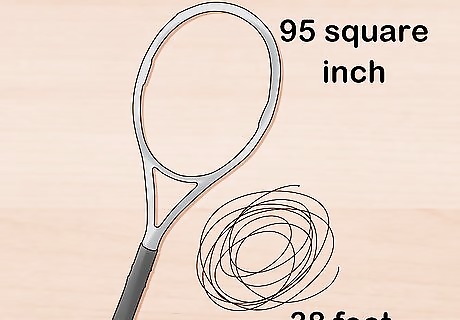
Measure out the string. Start by cutting 35 to 40 feet (10.7 to 12.2 m) (10 to 12 m) of new string off a spool. For a basic 95 square-inch racquet with a basic crossing pattern, you'll probably need about 38 feet (11.6 m) of string to finish the job. In general, it's better to have cut off too much and waste some than start with too short a piece and have to start over. After you string up your racquet the first time, account for the extra you've used to tie the knots and cut a piece of the appropriate size for your racquet. Start with too much and home in on your ideal string length.

Prep the racquet for stringing. Use a sharp knife, cut the old and broken strings out of the racquet as soon as possible after you decide they're worn out, or one breaks. Start with the strings in the middle of the racquet and cut towards the outside strings. Inspect the rubber grommets on the rim of the racquet for signs of wear and have new grommets installed if necessary.
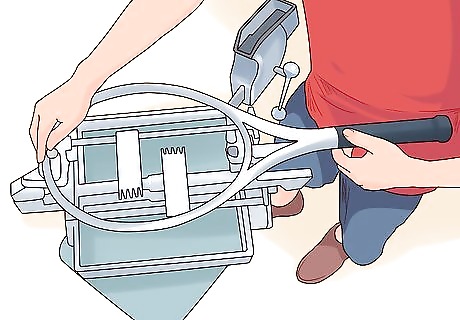
Mount the racquet on the stringing machine. Depending on the specific restringing machine you're using, the mounting process will be slightly different. Secure the head and the neck of the racquet in the designated mounting brackets and press down on the clamps to secure it firmly. Adjust the tension as directed. 6-point mounting systems distribute the tension on the racquet more evenly, but whatever kind of machine you're using, you need to make sure the clamps are secured on the racquet. It should be tight enough to stay still when you shake the grip, but not so tight as to warp the frame.
Restringing Technique
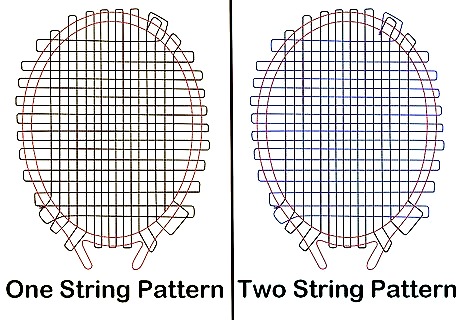
Select between a one-piece or two-piece stringing pattern. Any racquet can be strung in one of two ways, by using one piece of string for both the horizontal and vertical stringing, or by using a separate piece for each. Some tennis players think using a single piece of string increases the life of the set and the racquet, while the proper technique on some racquets makes the use of two pieces more desirable. It's important to string the cross strings from the end of the racquet (called the head) to the bottom of the face of the racquet, close to the handle (called the throat). This is because the tension of the strings can warp the racquet significantly, and since the throat is weaker than the head, it's better to start at the top and work down. This can be difficult with one piece of string, and impossible on some racquets.

Pull the main strings. The main strings run parallel to the long axis of the racquet. Insert the string into the holes at the head of the racquet, thread it down through the neck and back up to the head. Secure the end of the string into the grip and move the rod into the horizontal position. This might require you to readjust the length of string you initially threaded through the racquet. Tighten the string by twisting the rod to the proper specifications for your racquet. Fix the second string using the second clamp and release the first string. Continue threading and clamping until all holes have been strung, tightening one, securing the next, and then releasing the previous string.
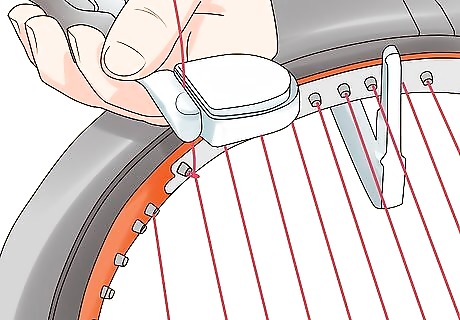
Knot the main strings. After you've secured all the main strings, release the tension rod and tie the end of the string securely, using needle-nose pliers and a small awl, if necessary. Tie a firm knot from the short end onto one of the taught vertical strings. Cut off excess string.

String the crosses. When you get to the last main row of the vertically-oriented main strings, you'll tie the string off and start on the crossing pattern. Cross strings run perpendicular to the long axis of the racquet. Insert string into one hole, usually designated by a slightly-larger grommet, and weave the string over and under the main string to the other side. Apply the same amount of tension you applied to the main strings and clamp the first string. Continue weaving until all crosses are strung. If you're going to use two pieces of string, tie the crossing string to a main string at the head, then thread it back through the big grommet on the nearest edge of the rim, proceeding as normal. Try to rub the crossing strings on the main strings as little as possible. Wearing the main strings before you even use them will decrease the life of the strings and the racquet.
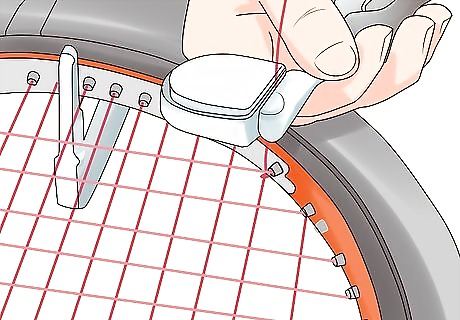
Knot the cross strings. Thread the last crossing string back through one of the main grommets and tie it securely to a main string, knotting it with needle-nose pliers. Release the tension and cut off excess string, then remove the racquet from the mount.
Customizing Your Racquet
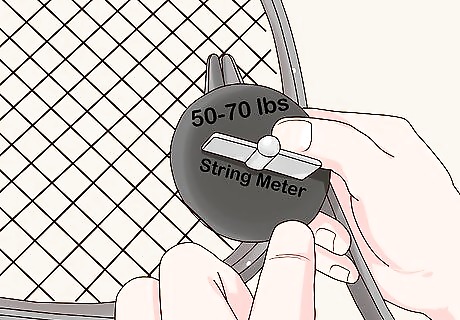
Choose your desired string tension. Most racquets have recommended tension measurements printed on the racquet, somewhere in the range of 50 to 70 lbs. (23 to 32 kg). Within that range, players will sometimes customize the amount of tension on the strings to create sweet spots particular to their individual style of play. For more control over the ball, keep strings tighter. Tight strings allow for more touch and accuracy. For more power, looser strings are recommended. Set the tension measurement on the stringer accordingly and play with different tensions to learn what works best for your style and racquet.
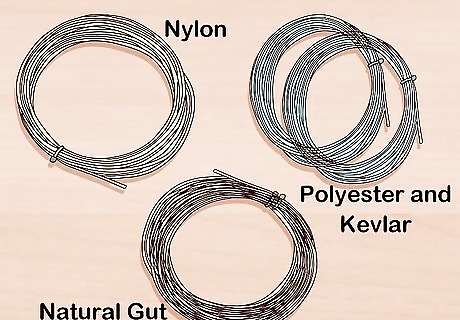
Use different strings. Experiment with different strings and brands until you find a durable string with a good resiliency. Most tennis strings are made of Kevlar, a strong synthetic fiber. Zyex is also being used for tennis racquet strings for its extra rebound ability, though other varieties are also available: Nylon strings are the cheapest and most popular strings for their versatility and crisp touch. Polyester and Kevlar strings are best for heavy-hitters and habitual string-wreckers. These durable strings work best in tandem for optimum strength and control. Natural gut strings are the most expensive, sensitive, and fragile of the varieties, but also extremely popular among professional players for the liveliness, touch, and elasticity.
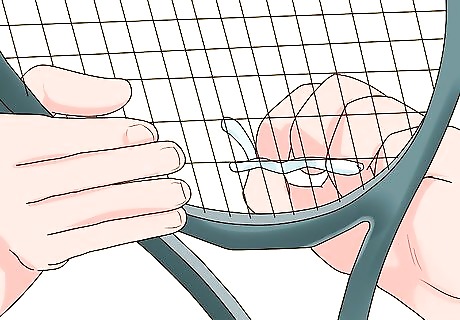
Consider using string dampeners and savers on your racquet. Small plastic platelets can be inserted into the crossing points of the strings to act as a barrier, protecting them from wear, and increasing the life of the racquet. Players who put a lot of topspin on the ball will likewise find an advantage in the use of string dampeners, which increase spin and dampen the strings. Try them out on the court and see what you think.

Restring your racquet as many times a year as you play in a week. If any of your strings break, it's obviously time for a restring, but what about a regular routine? A good rule of thumb is to restring your racquet as many times annually as you play weekly. So, if you play twice a week, restring your racquet every six months or so. Heavier players and big hitters will likely need to restring their racquets more regularly than occasional players. Expert Answer Q When asked, “When should you restring your tennis racquet?” Peter Fryer Peter Fryer Tennis Instructor Peter Fryer is a tennis writer and coach based in Derry Northern Ireland. He completed his professional teaching tennis qualification shortly after finishing university and has been teaching tennis for over 13 years. Peter began Love Tennis Blog in 2010 and contributes to the BBC and national media outlets. Peter Fryer EXPERT ADVICE Answer from Peter Fryer: Peter Fryer, a tennis pro, responded: “The general rule is to restring your racquet as many times per year as you play per week. This prevents your strings from going dead and ensures your racquet always offers good performance.”




















Comments
0 comment